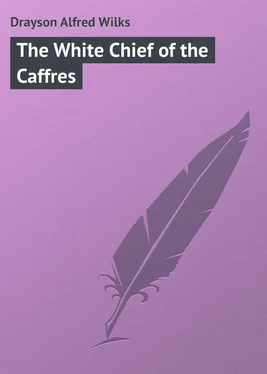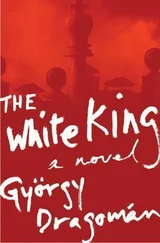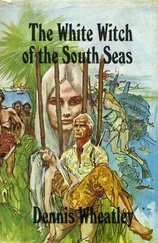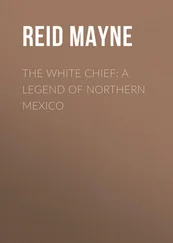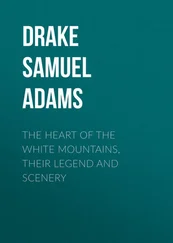Alfred Drayson - The White Chief of the Caffres
Здесь есть возможность читать онлайн «Alfred Drayson - The White Chief of the Caffres» — ознакомительный отрывок электронной книги совершенно бесплатно, а после прочтения отрывка купить полную версию. В некоторых случаях можно слушать аудио, скачать через торрент в формате fb2 и присутствует краткое содержание. Жанр: Прочие приключения, foreign_prose, на английском языке. Описание произведения, (предисловие) а так же отзывы посетителей доступны на портале библиотеки ЛибКат.
- Название:The White Chief of the Caffres
- Автор:
- Жанр:
- Год:неизвестен
- ISBN:нет данных
- Рейтинг книги:4 / 5. Голосов: 1
-
Избранное:Добавить в избранное
- Отзывы:
-
Ваша оценка:
- 80
- 1
- 2
- 3
- 4
- 5
The White Chief of the Caffres: краткое содержание, описание и аннотация
Предлагаем к чтению аннотацию, описание, краткое содержание или предисловие (зависит от того, что написал сам автор книги «The White Chief of the Caffres»). Если вы не нашли необходимую информацию о книге — напишите в комментариях, мы постараемся отыскать её.
The White Chief of the Caffres — читать онлайн ознакомительный отрывок
Ниже представлен текст книги, разбитый по страницам. Система сохранения места последней прочитанной страницы, позволяет с удобством читать онлайн бесплатно книгу «The White Chief of the Caffres», без необходимости каждый раз заново искать на чём Вы остановились. Поставьте закладку, и сможете в любой момент перейти на страницу, на которой закончили чтение.
Интервал:
Закладка:
Having driven the cattle home to the kraal, we ate some corn and drank some milk, and then ran back to where our trap had been constructed, and climbed into a large tree, from which we could obtain a good view all round. It had not even become dark when, as we sat silent and motionless in the tree, we saw the leopard come through some long grass and creep towards our trap. It crouched for some time near the trap and seemed to be listening, and then slowly crept in. In half a minute the door dropped, and the leopard was trapped. In an instant Inyoni descended the tree and ran off to the kraal, whilst I and Tembile remained up the tree. We could hear the leopard moving about inside the hut, but whenever he did so we called out, and he was at once silent, and appeared as if he were afraid of making any noise.
In what appeared to be a very short time Inyoni came back, and with him about twenty men, among whom was the chief. They were all armed with five assagies each, and one of the men carried a piece of wood that was on fire. The Caffres came up very quietly, and then surrounded the hut, remaining about ten yards from it. In a few minutes dry wood had been collected, and seven or eight fires were made round the trap in which the leopard was a prisoner. Sometimes the leopard would roar and tear at the side of his cage, but on hearing the Caffres outside he would become quiet again, and so the night passed. Soon after daybreak many more Caffres came to us, for the news had spread to the villages round, and when the sun rose there were more than a hundred Caffres round the trap. The chief now gave his orders, and the men obeyed him just as soldiers obey an officer. He directed one Caffre to go to the door of the trap, and with a long pole push up the door; all the other Caffres stood in a semicircle round the doorway and about fifty yards from it, each with an assagy in his hand ready to throw. No sooner was the door raised a few inches than the leopard rushed at the stick, scratching and biting at it furiously. The Caffre then retreated, and the leopard struggled at the small opening and succeeded in getting half out. The chief then shouted “ Bulala !” and about forty assagies were thrown at the leopard, nearly a dozen of which entered its body. In spite of these wounds the animal struggled out of the doorway and sprang at the Caffres in front of him. A shower of assagies were again hurled at him, but he succeeded in reaching one man, whom he seized by the leg with his claws. In an instant, however, the other men closed in: there was a struggling mass of men, and then a shout of “ Yena gofile ” (“he is dead.”) I rushed up to the crowd, and there was the leopard covered with blood, his lips drawn back showing his teeth, and his limbs extended as they had been in his last spring. I jumped about with delight and excitement, for this was the first leopard I had ever seen killed, and it was by the aid of my trap that he had been secured.
The legs of the leopard were tied together, and a long pole was then inserted between them, and he was carried to the kraal, the men singing songs as they accompanied his body. Two men immediately set to work to skin him, they then extracted his teeth and claws. Of the use they were going to make of these latter I at the time was ignorant, but in a few days I learned their value. All the principal men from the neighbouring kraals were invited to come to our village in the evening, for the Caffres intended to eat the leopard, the flesh being supposed to give a man courage and endurance. A very small piece of meat could be spared for each man, as there were more than a hundred men assembled. They all sat in a circle on a piece of level ground outside our village, a fire being lighted in the centre, at which the leopard, cut up into pieces, was being toasted. Many songs were sung by the men, the chorus being shouted by all. This chorus was very little more than “ Ingwe gofile, Tina shiele, Yena shingarner, Yena gofile :” which meant, “The leopard is dead, We have struck him, He is a rascal, He is dead.”
We sat several hours singing songs that were extemporised by the best singers, and occasionally drinking Itchuala , a sort of beer made out of corn, and then we all retired to our huts and slept. Three days after this the same men assembled at our kraal in the evening, and I was told by the chief to come to the meeting. I did not know what it was for, but I found all the Caffres looking at me, and the young girls seemed to regard me most attentively. I thought perhaps they intended to eat me, though I had seen nothing since my capture that frightened me. When the men were seated in a circle, the chief stood up, and, going into the centre of the circle, made a long speech, which was to this effect: “This white boy I prevented from being assagied; some of you wished to kill him, but I said, ‘No – he shall be as my son, let him live.’ You agreed, and he lives. Though his skin is white, his heart is the heart of an Umzimvubu. He can throw an assagy well. He thinks, and it is he who made the trap that caught the leopard. I ask you, men, does he not deserve the necklace of leopard’s claws? Shall he not be a young chief? Say, men, what you think.”
There was immediately a shout of consent, and the chief, calling me to him, gave me a necklace made out of the claws of the leopard, which he fastened round my neck, and immediately the men shouted, “ Inkosana !”
“He is a young chief!”
I have, since those days, heard of men who by deeds of valour have gained the Victoria Cross, or by good service have received honours from their sovereign; but I doubt if any of these felt more pride and gratification than I did when I received this necklace of leopard’s claws from the hands of the chief. I immediately felt a craving for opportunities of distinguishing myself, and wished for another chance at a leopard or at some other savage animal, in order that I might prove my courage, as ably as I had shown my skill in designing and constructing the leopard-trap.
Chapter Four
There was a great change in the behaviour – of the Caffres towards me now that I had been made an Inkosana. Before this dignity had been conferred on me, there was a kind of watch kept on me; but now every Caffre, man, woman, and child, seemed to regard me as one of themselves. I was now always given amasi to drink instead of ubisi , the former being considered suitable for men, the latter for women and children. Finding myself a person of greater importance, I one day asked Inyati if I might go and see my white friends. He hesitated for some time, and at length said: “To-morrow at sunrise you may go. Inyoni will show you the way; you will reach their kraal when the sun goes down. Stay one day, then return.”
I told Inyati I would do as he told me, and on the following morning I started with Inyoni on the journey. I had never asked what had become of the men and sailors who had been saved from the wreck. At first I did not ask because I did not know a word of Caffre, but afterwards I did not do so because I saw that the Caffres seemed disinclined to make any answers to my questions. Now, however, I was alone with Inyoni, he told me all the details of the massacre. He told me how we had been watched for two days, and it was found that the men had firearms; so they were all killed. On my inquiring why they were killed, Inyoni told me that many moons ago some white men had come on the coast, and had landed and had carried off some men and women from a kraal; that when the Caffres had assembled to get back their friends, the white men had fired their guns at them and had killed several Caffres, and then escaped in their boats. So that the chiefs had agreed that, if ever white people came again on the coast, they were to be watched, surprised, and the men assagied. From what I afterwards learned, I believe the men who thus visited the coast were slave-hunters.
Читать дальшеИнтервал:
Закладка:
Похожие книги на «The White Chief of the Caffres»
Представляем Вашему вниманию похожие книги на «The White Chief of the Caffres» списком для выбора. Мы отобрали схожую по названию и смыслу литературу в надежде предоставить читателям больше вариантов отыскать новые, интересные, ещё непрочитанные произведения.
Обсуждение, отзывы о книге «The White Chief of the Caffres» и просто собственные мнения читателей. Оставьте ваши комментарии, напишите, что Вы думаете о произведении, его смысле или главных героях. Укажите что конкретно понравилось, а что нет, и почему Вы так считаете.
